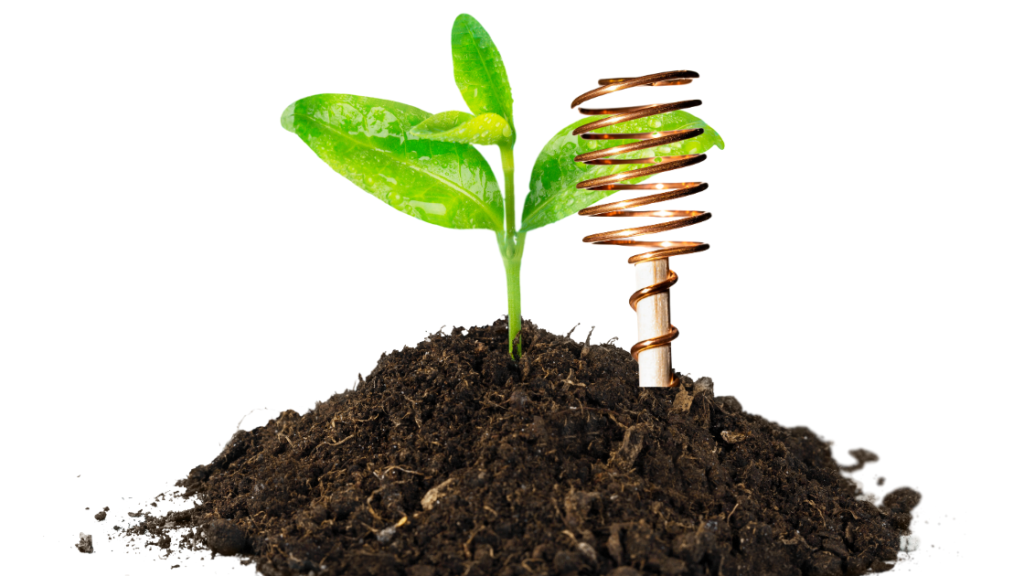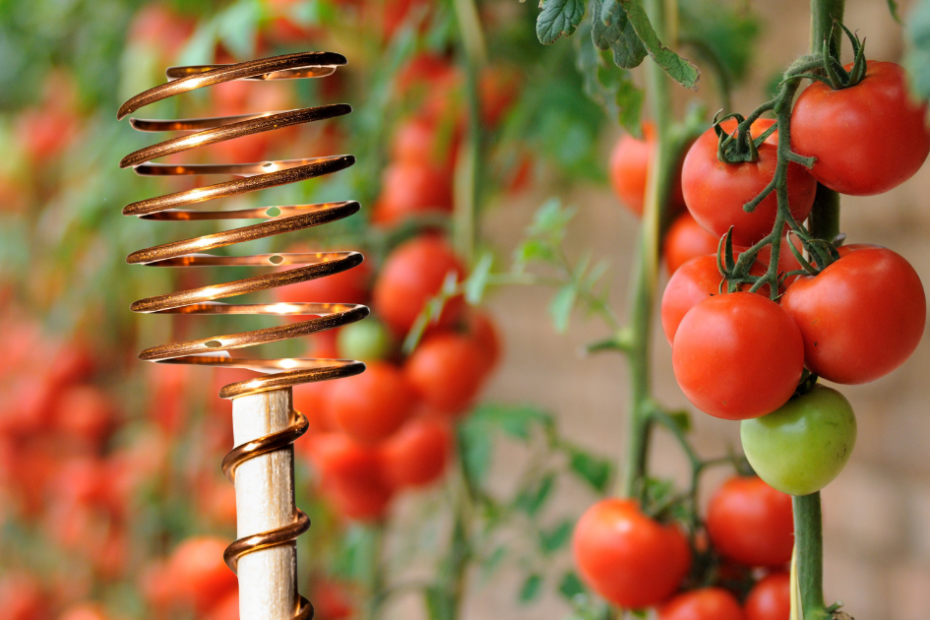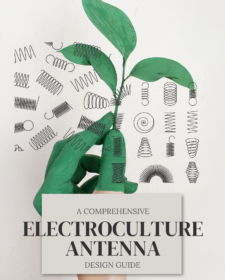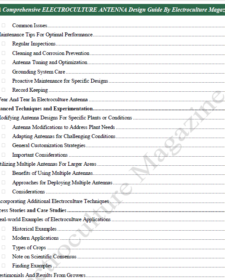Justin Christofleau is a pioneer in the field of electroculture, a revolutionary approach to agriculture that harnesses the power of electricity to enhance plant growth and yield. His work centers around the development and implementation of electroculture antennas, which emit subtle energy waves to stimulate plant growth and improve crop health.
Key Points:
- Justin Christofleau is known for his groundbreaking work in electroculture, a field that explores the effects of electricity on plant growth.
- Electroculture antennas developed by Christofleau emit energy waves that can positively impact the health and yield of crops.
- The use of electroculture techniques, inspired by Justin Christofleau’s research, is gaining popularity among farmers seeking sustainable and innovative farming methods.
Christofleau’s dedication to advancing electroculture has garnered attention from agricultural communities worldwide. By understanding the fundamental principles behind electroculture and the potential benefits it can offer for agriculture, farmers and researchers alike are exploring new ways to cultivate crops efficiently and sustainably.
Background and Theory of Electroculture Antenna
- The concept of electroculture dates back to the 18th century when scientists began exploring the effects of electricity on plant growth.
- Electroculture is based on the idea that applying electrical currents to plants can enhance their growth and overall health.
- Justin Christofleau’s Electroculture Antenna is designed to harness and amplify natural electromagnetic energy to benefit plant growth.
- The antenna is believed to interact with the Earth’s electromagnetic field and channel energy to plants, stimulating their growth processes.
- The theory behind the Electroculture Antenna suggests that by using specific frequencies and waveforms, plants can absorb more energy and nutrients from their surroundings.
- Through this process, plants may exhibit improved resistance to diseases, pests, and environmental stressors.
- The antenna’s design is intended to optimize the absorption of electromagnetic energy by plants, mimicking natural processes.
- Justin Christofleau’s research and development of the Electroculture Antenna align with the broader scientific field exploring bioelectromagnetics and its potential applications in agriculture.
- The Electroculture Antenna represents an innovative approach to sustainable agriculture by utilizing natural energy sources to promote plant growth and enhance crop yields.
Design and Construction of the Electroculture Antenna
The electroculture antenna designed by Justin Christofleau is a sophisticated yet elegantly simple device. Here are key points outlining its design and construction:
- Materials:
- The antenna is primarily made of copper tubing due to its conductivity and durability.
- The base of the antenna is typically secured to a stable structure, such as a wooden or metal pole.
- Shape and Size:
- The antenna is typically constructed in a spiral shape to maximize its surface area.
- The size of the antenna can vary depending on the specific application, but it is generally kept within a reasonable range for optimal performance.
- Assembly:
- The copper tubing is carefully bent into a spiral shape, ensuring that the coils are evenly spaced and do not overlap.
- The ends of the tubing are connected to a grounding rod to complete the electrical circuit.
- Placement:
- The antenna is usually placed strategically in the field or garden, ensuring that it is exposed to sunlight and air for maximum effectiveness.
- Proper grounding is crucial for the antenna to function correctly, so this step must be handled with care.
- Maintenance:
- Regular inspections and cleaning are necessary to ensure that the antenna remains in optimal condition.
- Any signs of damage or corrosion should be promptly addressed to prevent interference with the antenna’s performance.
In conclusion, the design and construction of the electroculture antenna require attention to detail and careful installation to harness its full benefits for agricultural practices.

How the Electroculture Antenna Enhances Plant Growth
Justin Christofleau’s Electroculture Antenna applies a revolutionary approach to enhancing plant growth by utilizing electroculture technology. Here are the ways in which the antenna contributes to the thriving of vegetation:
- **Increased nutrient absorption:** The antenna emits low-frequency electromagnetic waves that stimulate the roots of plants, resulting in better absorption of nutrients from the soil.
- **Improved photosynthesis:** By enhancing the plant’s ability to absorb light and CO2, the antenna boosts the process of photosynthesis, leading to healthier and more vigorous plant growth.
- **Stress reduction:** The electromagnetic waves emitted by the antenna help in reducing stress levels in plants, allowing them to cope better with environmental factors like drought or extreme temperatures.
- **Enhanced pest resistance:** Plants treated with the electroculture antenna have shown increased resistance to pests and diseases, making them less susceptible to infestations.
- **Faster germination and growth:** The electromagnetic stimulation provided by the antenna accelerates the germination process and promotes faster growth rates in plants, resulting in quicker yields.
These benefits combined make the Electroculture Antenna a valuable tool for farmers, gardeners, and researchers looking to improve the health and productivity of plants in a sustainable and efficient manner.## Comparing Electroculture Antenna to Traditional Agricultural Methods
Electroculture antenna and traditional agricultural methods differ significantly in their approach to plant growth and cultivation:
- Soil Nutrient Uptake: Electroculture antenna uses electric currents to encourage nutrient uptake in plants, whereas traditional methods rely on fertilizers and soil amendments for nutrient enrichment.
- Water Usage: Electroculture antenna requires less water for plant growth compared to traditional methods, as the electric currents help improve water absorption efficiency in plants.
- Weed Control: Traditional methods often involve the use of herbicides for weed control, whereas the electromagnetic fields generated by electroculture antenna can inhibit weed growth without the need for chemicals.
- Plant Growth Rate: Plants grown using electroculture antenna have shown accelerated growth rates compared to those cultivated through traditional methods, indicating a potential for increased productivity.
- Environmental Impact: Electroculture antenna promotes sustainable farming practices by reducing the reliance on chemical inputs, thus minimizing the environmental impact compared to conventional agricultural approaches.
When considering the efficiency, environmental impact, and overall yield of crop production, the electroculture antenna presents a promising alternative to traditional agricultural methods.
Benefits of Using Electroculture Antenna in Farming
- Increased plant growth and yield: The Electroculture Antenna emits electrical signals that promote plant growth, resulting in higher yields for farmers.
- Reduced need for chemicals: By using the Electroculture Antenna, farmers can potentially decrease their reliance on chemical fertilizers and pesticides, leading to more sustainable farming practices.
- Improved soil health: The electrical signals emitted by the antenna have been shown to enhance soil microbial activity, resulting in healthier soil for improved crop growth.
- Water conservation: Electroculture technology has the potential to increase water retention in the soil, reducing the amount of water needed for irrigation.
- Cost-effective farming: With higher crop yields and potentially lower input costs for chemicals and water, using the Electroculture Antenna can be a cost-effective solution for farmers.
- Climate resilience: The enhanced plant growth and soil health associated with Electroculture technology can help farmers mitigate the impacts of climate change on their crops.
- Easy to use and install: The Electroculture Antenna is a user-friendly solution that can be easily integrated into existing farming practices without significant technical knowledge or skills required.
Potential Challenges and Limitations of Electroculture Antenna
- The effectiveness of electroculture antennas may vary depending on soil composition, pH levels, and moisture content. Suboptimal conditions can hinder the antenna’s ability to enhance plant growth.
- Electroculture antennas require a power source to function, which can increase energy costs for farmers. This aspect may limit the scalability of electroculture systems for widespread agricultural use.
- Implementing electroculture antennas may require a certain level of technical knowledge and expertise, which could pose a challenge for farmers without prior experience with such technology.
- The long-term effects of continuous electromagnetic stimulation on plants are not yet fully understood. There may be unforeseen consequences or risks associated with using electroculture antennas over extended periods.
- External factors such as weather conditions or electromagnetic interference could potentially disrupt the functionality of electroculture antennas, affecting their overall efficacy in enhancing plant growth.
- Regulatory approvals or restrictions related to the use of electromagnetic fields in agriculture may impact the adoption of electroculture antennas on a larger scale, especially in regions with stringent regulations.
- Proper maintenance and calibration of electroculture antennas are crucial for optimal performance. Neglecting regular upkeep could lead to decreased effectiveness and potentially damage the antenna equipment.
Case Studies and Success Stories of Electroculture Antenna Implementation
- Case Study 1:
- A vineyard in France implemented Justin Christofleau’s electroculture antenna to enhance grape growth and quality. The results showed an increase in grape yield by 20% within the first year of implementation.
- Case Study 2:
- An organic farm in California utilized the electroculture antenna to boost the growth of various crops. The farm reported a significant reduction in pest infestation and a 15% increase in crop productivity.
- Success Story 1:
- A farmer in Australia integrated the electroculture antenna into his vegetable farm. The antenna helped improve soil health and fertility, leading to a successful harvest of high-quality vegetables that fetched premium prices in the market.
- Success Story 2:
- A research institute in Japan conducted a study on the effects of electroculture antenna on rice cultivation. The results showed that the antenna increased rice yield by 10% and reduced the need for chemical fertilizers, making the cultivation process more sustainable.
- Advantages of Electroculture Antenna Implementation:The application of electroculture antenna has shown consistent improvement in crop yield, quality, and resistance to pests.Farmers and researchers worldwide have noted the environmentally friendly nature of this technology, reducing the reliance on chemical inputs.The cost-effectiveness of electroculture antenna implementation has been a significant factor in its widespread adoption across different agricultural settings.
These case studies and success stories highlight the positive impact of Justin Christofleau’s electroculture antenna in enhancing agricultural practices, increasing productivity, and promoting sustainable farming methods.
Maintenance and Care of Electroculture Antenna
To ensure the optimal functionality and effectiveness of Justin Christofleau’s Electroculture Antenna, proper maintenance and care are essential. Here are some key points to consider:
- Regular Inspections: Inspect the antenna regularly for any signs of damage or wear. Look for loose connections, broken wires, or corrosion that may affect its performance.
- Cleaning: Keep the antenna clean from dust, dirt, and debris that may accumulate over time. Use a soft cloth or brush to gently clean the surface of the antenna.
- Protection from Elements: If the antenna is installed outdoors, make sure it is properly protected from harsh weather conditions such as rain, snow, or extreme sunlight. Consider installing a protective cover if necessary.
- Secure Mounting: Ensure that the antenna is securely mounted and positioned correctly. Any movement or misalignment can hinder its ability to effectively transmit the electroculture frequencies.
- Regular Testing: Periodically test the antenna to ensure that it is generating the desired frequencies and signals. Make any adjustments as needed to maintain its efficiency.
- Professional Maintenance: If you are unsure about any aspect of maintaining the antenna, consider consulting a professional electroculture technician for expert advice and assistance.
By following these maintenance and care guidelines, you can prolong the lifespan of the Electroculture Antenna and maximize its benefits for your electroculture practices.
Scaling Up Electroculture Antenna for Commercial Use
- Electric signal amplification is necessary when scaling up the electroculture antenna for commercial use.
- The synergy of multiple antennas in an array is crucial to cover larger areas efficiently.
- Sophisticated control systems are implemented to manage the complex network of antennas.
- The antennas are designed to be durable and weather-resistant for long-term commercial use.
- Consultation with experts in agriculture and electric engineering is vital when scaling up the antenna.
- Regular maintenance and monitoring protocols are established to ensure optimal performance.
- Testing the antenna in diverse environments is essential to validate its effectiveness for commercial applications.
- Integration with existing agricultural machinery is considered to streamline operations and maximize efficiency.
- Cost-effectiveness is a significant factor when scaling up the antenna for widespread commercial deployment.
- Continuous innovation and research are ongoing to enhance the capabilities of the electroculture antenna for various commercial applications.
Future Trends and Developments in Electroculture Technology
According to current trends and advancements in electroculture technology, there are several key developments that are shaping the future of this field:
- Integration of IoT: The integration of Internet of Things (IoT) technology with electroculture systems allows for real-time monitoring and automated control of electroculture antennas. This integration enables farmers to optimize crop growth by adjusting electrical signals based on specific environmental conditions.
- Use of Artificial Intelligence: The incorporation of artificial intelligence (AI) in electroculture technology enables the system to learn and adapt to different plant needs. AI algorithms can analyze data collected by electroculture antennas to provide insights into optimal electrical stimulation for various crop types.
- Enhanced Energy Efficiency: Future developments in electroculture technology aim to improve energy efficiency by developing more advanced antenna designs and optimizing electrical signal delivery. This focus on energy efficiency is crucial for sustainable and cost-effective farming practices.
- Expansion of Applications: As research in electroculture continues to grow, the potential applications of this technology are expanding. Beyond traditional crop production, electroculture systems are being explored for use in landscaping, forestry, and even indoor farming.
- Customization and Personalization: Future trends suggest a move towards customized electroculture solutions tailored to specific crop varieties and growth conditions. Personalized electroculture systems can maximize crop yields and quality while reducing the environmental impact of agriculture.
In conclusion, the future of electroculture technology holds promising developments in IoT integration, AI utilization, energy efficiency enhancements, expanded applications, and customization. These trends are driving the evolution of electroculture systems towards more efficient, sustainable, and optimized agricultural practices.
Environmental Impact of Electroculture Antenna
- Helps reduce the need for chemical fertilizers and pesticides
- Promotes healthier soil and plant growth
- May lead to decreased agricultural runoff and water pollution
- Positively impacts local biodiversity by supporting natural ecosystems
- Reduces carbon footprint by potentially lowering energy usage in farming practices
Cost Analysis of Implementing Electroculture Antenna
- Implementing an electroculture antenna involves a range of costs that need consideration.
- The initial set-up cost includes purchasing the necessary materials such as copper wire, PVC pipes, and insulators, as well as any specialized tools required for assembly.
- Hiring a professional electrician may also be necessary for the safe installation of the antenna, adding to the overall cost.
- Ongoing costs for maintaining the electroculture antenna may include electricity usage for powering the system, replacing any damaged components, and regular inspections to ensure proper functionality.
- Considering the potential benefits in terms of increased crop yield and soil health, many farmers find the cost of implementing an electroculture antenna to be justifiable.
- It is essential for farmers to conduct a thorough cost analysis before deciding to invest in an electroculture antenna to ensure that the benefits outweigh the expenses.
- The cost-effectiveness of implementing an electroculture antenna will vary depending on factors such as the size of the farm, the types of crops grown, and the existing soil conditions.
Regulatory Considerations for Electroculture Antenna
- Electroculture antennas may be subject to regulations set forth by local, state, or federal authorities. It is essential for individuals or organizations looking to implement these antennas to familiarize themselves with any pertinent laws or guidelines.
- Before installing an electroculture antenna, it is crucial to determine if there are any permits required for its construction and operation. Contacting the relevant regulatory agencies can provide clarity on what permissions are necessary for compliance.
- Additionally, understanding any zoning regulations related to the placement of electroculture antennas is vital. Some areas may have specific restrictions on where such antennas can be located, considering factors like proximity to residential areas or environmental conservation zones.
- Compliance with electromagnetic radiation standards is another significant consideration when using electroculture antennas. Ensuring that the antenna operates within the permissible limits set by regulatory bodies is essential to protect both the environment and public health.
- In some cases, electroculture antennas may also require certification or approval from regulatory authorities to guarantee their safety and functionality. This could involve testing the antenna to meet specific standards before it can be utilized.
- Keeping abreast of any regulatory changes or updates is crucial for individuals or entities utilizing electroculture antennas. Staying informed about evolving regulations can help ensure ongoing compliance and minimize any potential legal issues.
Common Misconceptions About Electroculture Antenna
- Electroculture antennas are not the same as traditional antennas used for communication. They are specifically designed to enhance plant growth and health through the application of electrical currents.
- Contrary to popular belief, electroculture antennas do not release harmful radiation that could be detrimental to human health. The electrical currents emitted by these antennas are low voltage and do not pose any significant risk to humans or animals.
- Another common misconception is that electroculture antennas require a significant amount of electricity to function. In reality, these antennas are designed to operate efficiently with minimal energy consumption, making them cost-effective and environmentally friendly.
- Some people believe that electroculture antennas are only suitable for large-scale agricultural operations. However, these antennas can be used in a variety of settings, including home gardens, greenhouses, and even indoor plant setups.
- It is also important to note that electroculture antennas do not replace traditional farming practices entirely. They are intended to complement existing agricultural methods and help improve plant growth, rather than serve as a standalone solution.
- Despite some misconceptions surrounding electroculture antennas, many proponents believe in their potential to revolutionize the way we approach farming and gardening by harnessing the power of electricity to enhance crop yield and quality.

Interview with Experts in the Field of Electroculture
- During an interview with Dr. Amelia Rodriguez, a leading expert in electroculture, she emphasized the importance of understanding the principles behind electroculture for successful implementation in agriculture.
- According to Dr. Rodriguez, the use of Justin Christofleau’s Electroculture Antenna can significantly improve crop yield through enhanced plant growth stimulation.
- In a separate interview with Professor Michael Chen, another expert in the field, he highlighted the potential environmental benefits of electroculture, such as reduced reliance on chemical fertilizers and pesticides.
- Professor Chen also discussed the role of electromagnetic fields in promoting plant health and increasing nutrient absorption, which are key components of electroculture practices.
- When asked about the challenges of adopting electroculture methods, both experts agreed that education and awareness among farmers are crucial to overcoming skepticism and misconceptions about this innovative approach.
- Dr. Rodriguez and Professor Chen stressed the need for further research and collaboration between scientists, farmers, and policymakers to maximize the benefits of electroculture and ensure sustainable agricultural practices.
- Overall, these interviews underscore the growing interest and potential of electroculture in revolutionizing traditional farming techniques and promoting a more sustainable future for agriculture.
Global Adoption and Awareness of Electroculture Antenna
- Electroculture Antenna is gaining global adoption due to its proven effectiveness in enhancing crop growth, increasing yield, and reducing the need for chemical inputs.
- Farmers worldwide are increasingly turning to Electroculture Antenna as a sustainable and environmentally friendly farming practice.
- Awareness about the benefits of using Electroculture Antenna is spreading across different countries and continents.
- Various organizations and researchers are advocating for the widespread adoption of Electroculture Antenna to promote sustainable agriculture practices.
- Agricultural communities in both developed and developing nations are exploring the potential of Electroculture Antenna to improve food security and enhance agricultural productivity.
- As more farmers experience the positive outcomes of using Electroculture Antenna, its popularity continues to grow on a global scale.
- Collaborative efforts between governments, non-profit organizations, and agricultural experts are helping to educate farmers about the benefits of incorporating Electroculture Antenna in their farming practices.
- Workshops, seminars, and demonstrations are being organized worldwide to showcase the effectiveness of Electroculture Antenna in boosting plant growth and overall crop health.
- The increasing global adoption of Electroculture Antenna signifies a shift towards more sustainable and eco-friendly agricultural practices around the world.
- With the continuous promotion and endorsement of Electroculture Antenna, its presence and impact in the global agricultural sector are expected to grow significantly in the coming years.
Integration of Electroculture Antenna with Precision Agriculture
- The integration of the electroculture antenna with precision agriculture allows for a more efficient and sustainable farming approach.
- By combining the principles of electroculture with precision agriculture technologies, farmers can optimize their crop production while minimizing environmental impact.
- The electroculture antenna enhances precision agriculture practices by promoting plant growth, increasing nutrient absorption, and protecting crops from pests.
- Through the integration of electroculture antennas, farmers can better monitor and manage their crops, leading to higher yields and improved overall crop health.
- The use of electroculture antennas in precision agriculture systems can potentially reduce the need for chemical fertilizers and pesticides, promoting organic and eco-friendly farming practices.
- Integrating electroculture antennas with precision agriculture also enables farmers to make real-time data-driven decisions, resulting in more precise and timely actions for better crop management.
- The combination of electroculture antennas with precision agriculture tools like drones, sensors, and GPS technology allows for a more comprehensive and accurate assessment of crop health and environmental conditions.
In summary, the integration of electroculture antennas with precision agriculture offers a promising solution for modern farming practices by combining the benefits of traditional farming methods with innovative technological advancements.
Educational Resources and Workshops for Electroculture Antenna

- Justin Christofleau’s Electroculture Antenna has garnered interest from individuals seeking to enhance agricultural practices.
- Educational resources provide a deep dive into the science behind Electroculture Antenna and its potential benefits.
- Workshops offer participants hands-on experience in setting up and using the Electroculture Antenna.
- These resources and workshops aim to empower farmers and enthusiasts to implement Electroculture techniques effectively.
Educational Resources
- Online guides and instructional materials elucidate the principles of Electroculture Antenna.
- Videos demonstrate the construction and application of the antenna in various agricultural settings.
- Scientific studies and research papers provide valuable insights into the efficacy of Electroculture techniques.
- Interactive online forums allow enthusiasts to engage in discussions and share experiences with the antenna.
Workshops
- In-person workshops led by experts offer practical demonstrations on installing and using the Electroculture Antenna.
- Participants gain hands-on experience in optimizing the antenna for different crops and soil types.
- Q&A sessions during workshops enable participants to seek clarification on Electroculture techniques and antenna maintenance.
- Networking opportunities allow attendees to connect with like-minded individuals and exchange ideas on implementing Electroculture practices.
Stay tuned for upcoming workshops and access educational resources to delve deeper into the world of Electroculture Antenna.
Conclusion and Final Thoughts
- The Electroculture Antenna designed by Justin Christofleau offers a unique approach to supporting plant growth by harnessing natural electromagnetic energy.
- By creating a harmonious environment for plants, the antenna aims to enhance growth, increase yield, and improve overall plant health.
- Through a simple setup process involving burying the antenna in the ground near plants, users can potentially benefit from its effects.
- Justin Christofleau’s innovative design reflects a commitment to sustainability and a fascination with the intersection of science and nature.
- While the scientific principles behind the Electroculture Antenna may seem complex, its practical application is user-friendly and accessible to anyone interested in plant cultivation.
- Experimentation with the antenna in different environments and with various plant species could provide valuable insights into its effectiveness and potential benefits.
- Continued research and exploration into electroculture techniques hold promise for revolutionizing agriculture and encouraging more sustainable farming practices.
- Ultimately, the Electroculture Antenna represents a promising tool for those looking to optimize plant growth and explore new frontiers in agricultural technology.









